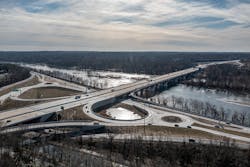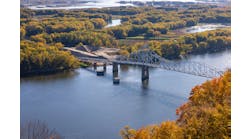Don’t let the name fool you. The Scudder Falls Bridge does not carry motorists over a waterfall. The name comes from an area of rapids located a half a mile north of the bridge, which is named after Richard Betts Scudder, who died on the New Jersey side in 1754.
Another chapter in the bridge’s history was written late last year, with the completion of a massive replacement project.
The Scudder Falls Bridge carries Interstate-295 over the Delaware River, connecting Bucks County, Pennsylvania, with Mercer County, New Jersey. The original bridge, designed by Michael Baker Jr. and constructed in 1959, had structural deficiencies and was suffering increasing congestion, prompting the replacement project.
The replacement project encompassed 4.4 miles of highway and bridge improvements, including the replacement of the existing four-lane bridge with two twin-span structures that carries six lanes of through traffic (three in each direction) with associated acceleration and deceleration lanes and full shoulders on each bridge.
The project also included safety upgrades to the two highway interchanges at both ends of the bridge. The upgrades included widening of I-295 to the inside to provide an additional travel lane from the bridge to the Route 322 interchange in Pennsylvania and construction of shoulders throughout the corridor to handle breakdowns and emergencies.
The two inside shoulder lanes on the bridge and approach roadways have the capacity to serve as potential future bus/rapid transit routes. Additionally, a new bike/pedestrian walkway on the upstream bridge provides a continuous connection between the two historic canal paths on both sides of the river.
The existing four-lane bridge was functionally obsolete and needed to be replaced to alleviate congestion and address projected future traffic volumes.
The bridge design evaluated precast concrete segmental, spliced precast concrete I Girder, and multi-girder steel superstructure types. Steel superstructures were selected for the two 1,850-foot, six span main river bridges and 7 ramp/approach bridges: with two structures utilizing precast concrete I-beams.
The design also included extensive use of tall retaining walls and noise walls. To reduce the amount of in-water work, Michael Baker increased the bridge span lengths to 279 feet, which allowed for the elimination of a pier line, from the conceptual design that was developed and permitted. Foundation design utilized 5-foot diameter drilled shafts with the fixed pier located at mid-span (i.e., in the center of the river), which then only required expansion joints at the two abutments. Proposed piers were offset from the existing bridge piers to avoid potential conflicts during construction.
Two roundabouts were constructed on the New Jersey side to improve the efficiency and safety of the interchange by replacing the existing intersection "scissor" ramps with yield conditions. Roadway work also included the widening of approximately 2.2 miles of I-295 (formerly I-95) on both approaches of the Main River Bridge. The design included SWM basins and mechanical devices with a complete overhaul of the drainage system.
Michael Baker's drainage upgrades included the use of bio-retention basins in New Jersey and pre-treatment forebays and infiltration basins in Pennsylvania to control runoff and treat the increased impervious pavement area. Throughout construction, existing rock elevations varied, and workers encountered boulders from the original highway construction, presenting a challenge.
Michael Baker’s design also included a new all electronic tolling (AET) collection system in the southbound direction, consisting of high-speed E-ZPass tag readers and video cameras to identify license plates for purposes of collecting tolls by mail from motorists that did not process an E-ZPass transponder. A four-story support building was constructed to house the AET and ITS equipment as well as the DRJTBC’s bridge monitoring staff.
The new Scudder Falls Bridge provides a safer corridor for the traveling public, with improved acceleration/deceleration lanes, faster travel times and reduced accident rates. R&B
Project: Scudder Falls Bridge Replacement Project
Location: Bucks County, Pennsylvania, to Mercer County, New Jersey
Owners: Delaware River Joint Toll Bridge Commission
Designer: Michael Baker International
Contractors: DRJTBC’s Program Manager/Design Manager Consultant: AECOM; Construction Management Prime Consultant: Hill International, Inc.; Construction Inspection Team: WSP (Main River Bridge), Gannet Fleming (New Jersey Approach), and TRC (Pennsylvania Approach); Contractor: Trumbull Corporation with PKF Mark III
Length: 1,740 feet
Completion Date: December, 2021



